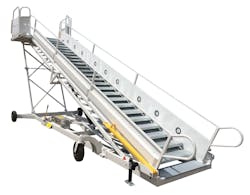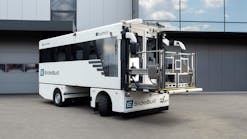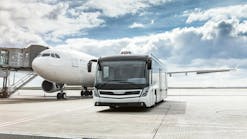A Simplified Approach to Passenger Boarding
The need for passengers to safely board and disembark aircraft is universal. However, some ground handling operations are not in need of fixed boarding bridges or stair trucks.
To assist customers in need of a passenger access solution, but cannot afford or do not need a stair truck, AERO Specialties provides a line of Towable Passenger Stairways.
According to Derek Rose, vice president of sales and marketing at AERO Specialties, the company’s line of towable stairs provides a low-cost method for passenger boarding and deplaning while complying with all Occupational Safety and Health Administration (OSHA) requirements and passenger safety protocols.
“These units are designed to be pushed up to the aircraft by hand,” Rose says. “That leads to less potential aircraft contact damage and safety issues.
“We offer three variants – regional aircraft capable, narrow-body aircraft capable and wide-body aircraft capable,” he continues. “Platform and stairway sizes are similar throughout.”
The height of the platform, and the subsequent number of steps, vary depending on the model. The line of Towable Passenger Stairways can service multiple door sill heights, with one model accommodating a range of 58″-93″, the next reaching 88″-161″ and the third extending to a height of 134″-223″.
With that flexibility, the line of Towable Passenger Stairways can service aircraft ranging from an ERJ to a B747.
“We have a model that is compatible with any aircraft that does not have its own stairway,” Rose points out.
Additional standard features include sliding handrails to clear the aircraft door, stabilizer jacks and non-marring soft rubber bumpers.
The most popular option for these stairs is an electric lift assist, according to Rose. He notes this feature replaces the need for a handpump to raise the stand. Furthermore, solar power panels can be added to a unit to charge the electric lift-assist battery.
“The grip strut footsteps are now galvanized for added durability,” Rose says, adding improved LED step and platform lights have been integrated as well.
Officials at AERO Specialties seek to keep these units as easy to use as possible.
“These are simple products that provide extreme durability and longevity of use,” Rose says. “The simple design makes them easy to maintain and operate.”
A general visual inspection and preventative maintenance for the hydraulic filters is required, as is checking the state of the battery for the light system and inspecting the wheels.
“Units should be washed and cleaned frequently, especially in corrosive environments,” Rose says.
Customer feedback has remained positive, and Rose says this is a testament to the simple design of the units.
“The units also can ship in a sea container, which makes them very popular with operators outside the USA,” he says.
“These are very popular with military customers as well as FBO and charter operations,” he continues. “This a popular option for customers with hardstand operations or locations that do not utilize a boarding bridge or have access or funding for a stair truck.”
When selecting passenger boarding stairs, a customer should consider what will be the smallest and the largest aircraft they intend to service.
Towing distance is also a factor when considering a towable stand versus a truck-mounted unit.
What’s more, the number of daily turns will have an impact on whether a towable unit or a truck-mounted unit is the best option for a specific location.
The ability to affordably handle passenger flights with an easy-to-use and low maintenance solution is an additional benefit.






